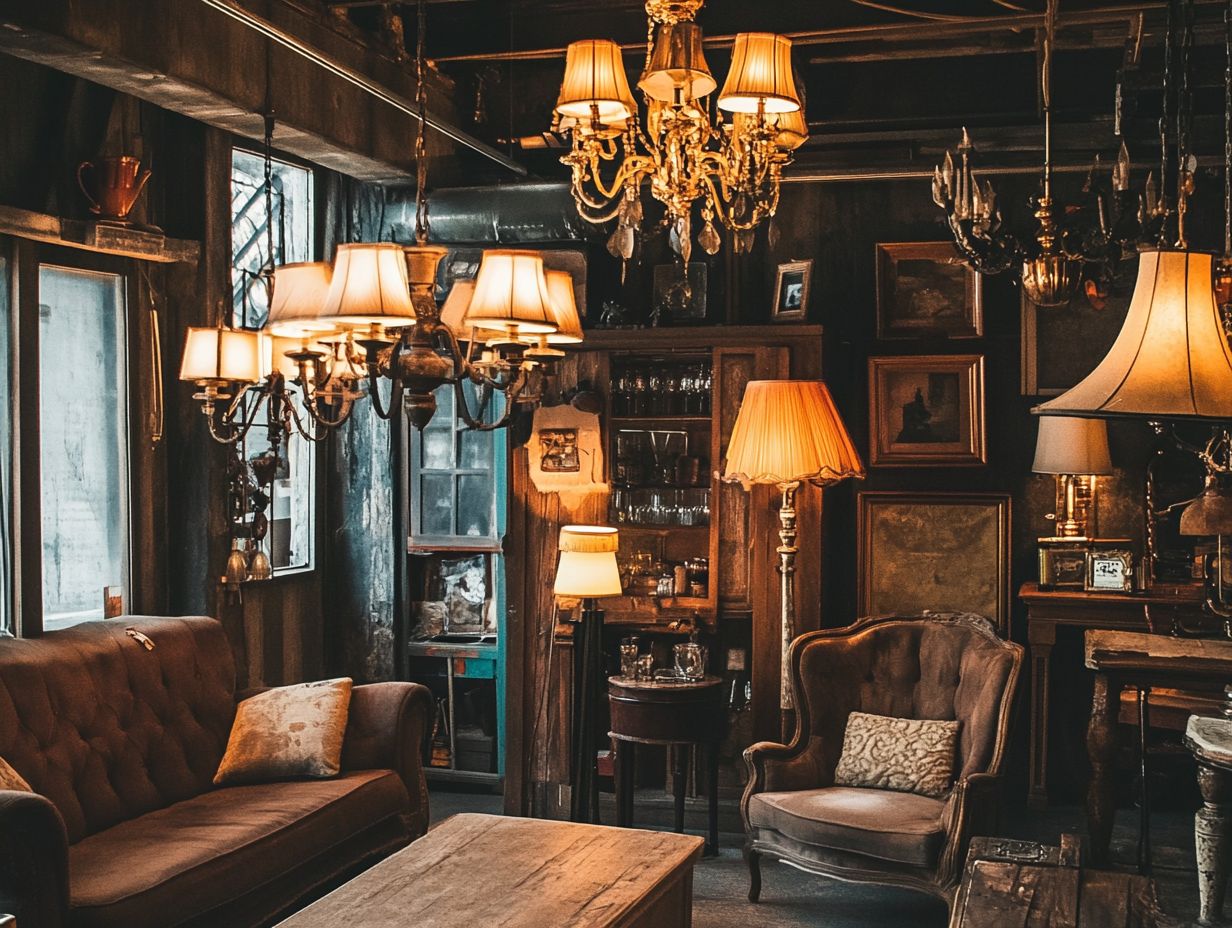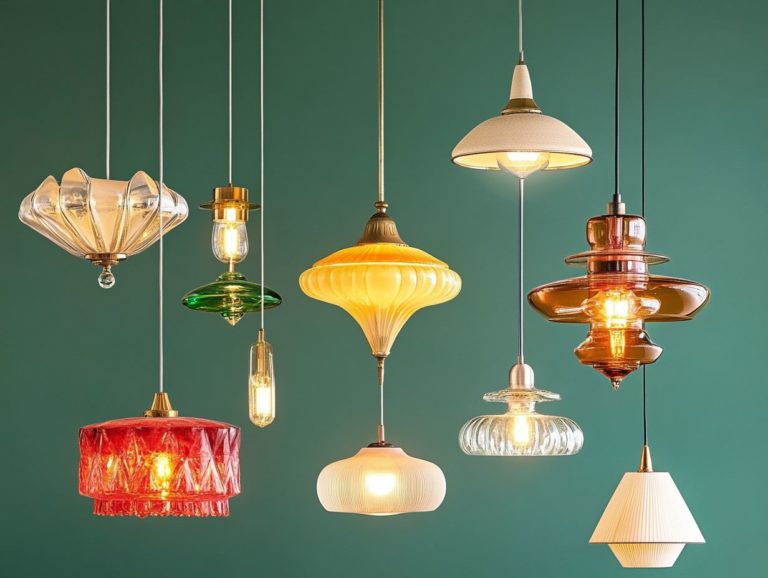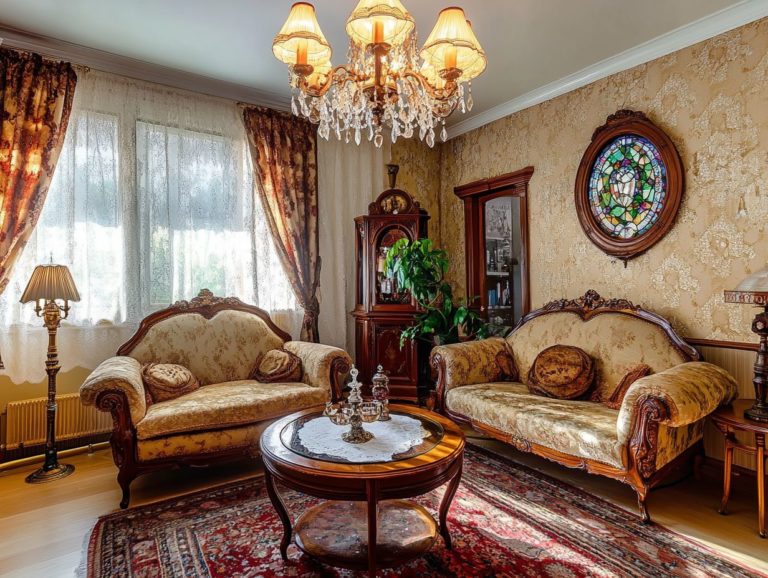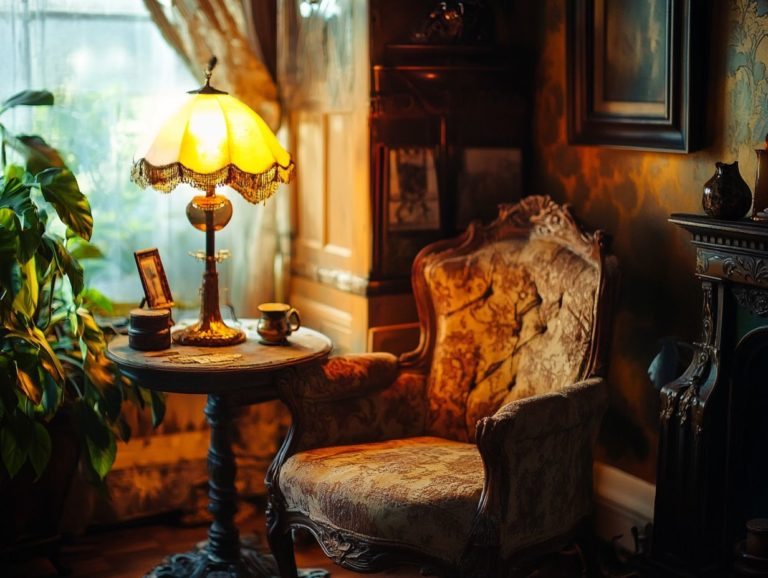5 Essential Tips for Buying Vintage Lighting
Vintage lighting can transform your space, adding character and charm that modern fixtures often lack. However, finding the perfect vintage piece can feel daunting at times.
This guide presents five essential tips to help you make informed decisions when purchasing vintage lighting. You’ll discover how to understand different styles, assess condition, and recognize authenticity and safety.
You will also learn how to integrate these timeless treasures into your contemporary decor. Let s dive in and explore the alluring world of vintage lighting!
Contents
- Key Takeaways:
- 1. Know the Different Types of Vintage Lighting
- 2. Consider the Age and Condition
- 3. Research the Brand and Designer
- 4. Check for Authenticity and Quality
- 5. Understand the Wiring and Safety
- What Makes Vintage Lighting Different from Modern Lighting?
- Frequently Asked Questions
- What are the 5 essential tips for buying vintage lighting?
- What should I look for when inspecting the condition of vintage lighting?
- How do I determine the right size and scale for vintage lighting in my space?
- What are some red flags to watch out for when checking the authenticity of vintage lighting?
- Why is it important to set a budget when buying vintage lighting?
- Are there any additional factors to consider when buying vintage lighting?
Key Takeaways:

- Understand the different types of vintage lighting for a smart purchase.
- Check the age and condition to ensure functionality and durability.
- Research the brand and designer to confirm the value and authenticity.
1. Know the Different Types of Vintage Lighting
Understanding the various types of vintage lighting is essential for anyone looking to elevate their interior decor with authentic pieces. This area includes a diverse array of styles, such as art deco, mid-century modern, and a multitude of light fixtures from chandeliers to unique lamps that contribute to a cohesive vintage aesthetic in your home.
By considering the unique characteristics of each style, you can make informed decisions that truly enhance your space. For example, art deco lighting, with its bold geometric shapes and opulent materials, adds a glamorous touch. Meanwhile, mid-century modern fixtures, defined by sleek lines and organic forms, exude understated elegance. If you’re looking to elevate your decor, explore the best places to find vintage lighting.
As you select your lighting, consider how it will harmonize with your existing furnishings and color palette. Don’t shy away from mixing styles; combining a vintage chandelier with contemporary decor or pairing retro lamps with modern art can create a captivating visual contrast. For those interested in enhancing their collections, refer to collecting vintage light fixtures: tips & tricks to elevate the overall ambiance of your home.
2. Consider the Age and Condition
When you explore the world of vintage lighting, you can make the best choice by evaluating the age and condition of the fixtures. These elements significantly impact their visual appeal and usefulness, ensuring you choose pieces that showcase exceptional craftsmanship and deliver the desired ambient and task lighting for your home.
To conduct a thorough condition assessment, start with a meticulous examination of the fixture’s materials. Look for signs of wear rust, discoloration, or damaged wiring as these clues can unveil underlying issues that need addressing to ensure both safety and longevity.
Caring for vintage bulbs, which often require special attention due to their unique construction, involves regular cleaning to eliminate dust and prevent overheating. Don t underestimate the importance of promptly replacing any frayed cords to avoid potential short circuits.
By prioritizing maintenance and recognizing the distinct needs of these treasured items, you can enjoy the beauty and warmth of vintage lighting while extending its lifespan.
3. Research the Brand and Designer
Researching the brands and designers behind vintage light fixtures can unveil invaluable insights into their historical significance, craftsmanship, and potential investment value. This is particularly true for pieces crafted by renowned designers like George Nelson and Serge Mouille, as well as brands such as Lightolier and Tiffany Studios, celebrated for their unique designs and exceptional quality.
To effectively explore this captivating realm, immerse yourself in a variety of sources, including auction house catalogs, design books, and reputable online platforms dedicated to vintage decor. Consider checking out tips for mixing vintage and modern lighting for innovative ideas. Engaging with collector communities through forums or social media groups can provide personal anecdotes and tips that enhance your understanding.
Provenance, or the history of ownership, is integral to the value of vintage lighting; knowing this can significantly elevate its desirability. Brands known for their craftsmanship and artistry not only enchant collectors but also possess the potential to appreciate in value over time. For those interested in enhancing their vintage lighting collection, understanding how to choose vintage light bulbs is essential. Therefore, conducting thorough research is essential for anyone eager to make wise investments in this fascinating field.
4. Check for Authenticity and Quality

Ensuring the authenticity and quality of vintage lighting fixtures is crucial for collectors and enthusiasts. Authentic vintage pieces resonate with historical significance and are often made from superior materials, elevating their value and enhancing your home decor.
To verify authenticity, closely examine marks that show who made the item, such as manufacturer stamps or tags. Searching for original signatures or unique craftsmanship details can also indicate authenticity. Documenting the provenance through receipts or expert appraisals adds an extra layer of security to your collection.
You can assess quality craftsmanship by looking at the materials used, the precision of the joinery, and the overall construction techniques. Conduct an electrical inspection to ensure safety and functionality. This protects your investment and enhances your peace of mind as you integrate these remarkable fixtures into your living space. For guidance on combining styles, check out how to mix vintage lighting in your decor.
5. Understand the Wiring and Safety
Understanding the wiring and safety of vintage lighting is essential. Many older fixtures may not meet current safety standards, which means they could need rewiring or thorough inspections of their electrical components.
Follow these steps to ensure safe wiring:
- Inspect the wiring for any frayed or exposed sections, as these can present significant hazards.
- Look for signs of wear or damage, such as burnt marks or melted plastic, which could indicate overheating.
- Once you identify potential issues, consult a professional electrician to determine whether the vintage fixture needs rewiring to meet modern safety regulations.
When installing or maintaining these fixtures, ensure they are connected to ground wires and use the appropriate voltage bulbs to prevent electrical mishaps. For more detailed guidance, check out this guide on how to care for your vintage lighting. Keeping these safety measures in mind prolongs the life of the fixture and protects your home.
What Makes Vintage Lighting Different from Modern Lighting?
Vintage lighting stands out from modern alternatives through its exceptional design sensibilities and craftsmanship. It reflects distinct design movements like Victorian, Art Deco, and Mid-Century Modern, evoking a rich sense of history and artistry.
This contrast allows vintage pieces to do more than just light up a room; they become conversation starters that infuse sophistication and nostalgia into modern interiors. For those looking to elevate their decor, consider 5 unique vintage lighting fixtures that showcase intricate details and elaborate forms, highlighting artisanal techniques. While modern lighting emphasizes energy efficiency and minimalism, vintage options bring character to any space.
These stunning details instantly elevate your space, making it truly unique! Vintage lighting maintains its practicality, whether through adjustable fixtures or ambient light that complements modern decor effortlessly. To learn more, check out this guide on how to incorporate vintage lighting in modern homes.
What Factors Affect the Value of Vintage Lighting?
The value of vintage lighting relies on several key factors, including the quality craftsmanship of each piece, its overall condition, historical significance, and the rarity of its vintage style. These elements dictate how sought-after a vintage lamp or fixture may be among collectors and interior decorators.
Consider a meticulously crafted Art Deco chandelier. Its fine materials and intricate design often command a premium price due to the exceptional skill required for its creation. To ensure you’re investing wisely, learn how to identify authentic vintage lighting. Conversely, a poorly maintained piece, even with historical significance, can see its value diminish considerably unless it undergoes careful restoration.
In today s collector market, there s a noticeable trend toward mid-century modern pieces. Mid-century modern designs are popular for their sleek lines and natural shapes. They are highly sought after and frequently fetch impressive sums at auctions.
Don t miss out on the chance to own these extraordinary pieces; they re captivating collectors everywhere! Collectors are increasingly captivated by unique designs that feature bold colors or unusual materials, valuing both aesthetic appeal and the seamless integration of the lighting within contemporary decor.
How Can You Tell If a Vintage Light Is Worth the Investment?

To know if a vintage light is worth investing in, you should evaluate its authenticity, quality craftsmanship, historical significance, and unique characteristics. These aspects are essential for understanding its potential to appreciate in value.
Look into current market demand to make an informed decision. Check online marketplaces and auction sites for similar items to see recent sale prices.
Consulting with experts or professional appraisers can offer insights into the piece s history, quality, and its value longevity.
Engage with vintage lighting enthusiasts and join forums to enhance your understanding. This connection will boost your confidence in making a solid investment.
What Are the Most Popular Styles of Vintage Lighting?
The most sought-after styles of vintage lighting include Art Deco, Mid-Century Modern, and Victorian designs. Each style captivates collectors and interior decorators alike.
Art Deco features striking geometric shapes and luxurious materials, adding glamour to any setting. Mid-Century Modern offers clean lines and organic forms that blend seamlessly with modern decor.
Victorian designs bring a nostalgic charm that suits traditional or eclectic themes. When sourcing these styles, prioritize quality and craftsmanship.
Check for original parts and visit reputable dealers. You might uncover hidden gems that add unique character to your space.
How Can You Incorporate Vintage Lighting into Modern Decor?
Incorporating vintage lighting into modern decor creates a distinctive blend that elevates your interior design. This blend highlights both vintage treasures and contemporary aesthetics.
Use vintage fixtures as statement pieces. A stunning retro chandelier can be the centerpiece of your dining area, complementing sleek, modern furniture.
Mix materials, such as pairing a brass lamp with a minimalist desk, to enhance the aesthetic. Utilize color palettes that resonate across both styles to unify the elements.
What Are Some Common Mistakes to Avoid When Buying Vintage Lighting?
When you’re in the market for vintage lighting, it’s easy to trip up on a few common missteps. Don’t let safety hazards dim your vintage charm! Overlooking the condition of the piece, neglecting to inspect for worn-out or old wiring, and failing to confirm compliance with safety standards can lead to acquiring fixtures that might not be safe or functional for modern use.
To make sure your vintage lights elevate your decor without introducing safety hazards, start by conducting a thorough assessment of each piece’s physical condition. Inspect for cracks, chips, or damage. Ensure all parts are intact and the wiring functions well. Additionally, consider some tips for finding affordable vintage furniture to complement your decor. Keep an eye out for signs of wear, such as rust or damage, which can indicate whether the fixture has received proper maintenance in the past.
Don’t underestimate the importance of inspecting the wiring; worn-out or old wiring could spell serious trouble when it comes to the safety of your home’s electrical system. Looking for certificates or labels that indicate compliance with current safety standards will offer you much-needed peace of mind.
Consider hiring a professional electrician for any necessary upgrades, ensuring that these charming fixtures not only light up your space but also adhere to today’s safety requirements.
Frequently Asked Questions

What are the 5 essential tips for buying vintage lighting?
The 5 essential tips for buying vintage lighting are:
- Do your research and familiarize yourself with different types of vintage lighting styles.
- Inspect the condition of the vintage lighting carefully.
- Consider the size and scale of the vintage lighting in relation to your space.
- Check the authenticity and origin of the vintage lighting.
- Set a budget and stick to it.
What should I look for when inspecting the condition of vintage lighting?
When inspecting the condition of vintage lighting, pay attention to any cracks, chips, or damage to the materials. Check if all the parts are intact and if the wiring is still functional. Additionally, look for signs of rust, corrosion, or discoloration.
How do I determine the right size and scale for vintage lighting in my space?
To determine the right size and scale for vintage lighting in your space, consider the height and width of the room as well as the overall design aesthetic. You can also take measurements of the intended area to ensure the vintage lighting will fit properly.
What are some red flags to watch out for when checking the authenticity of vintage lighting?
Some red flags to watch out for when checking the authenticity of vintage lighting are missing or mismatched parts, poor quality materials, and a lack of information about the history or origin of the piece. Be wary of sellers making big claims without proof.
Why is it important to set a budget when buying vintage lighting?
Setting a budget when buying vintage lighting can help prevent overspending and ensure that you are getting the best value for your money. Additionally, vintage lighting can vary widely in price, so having a budget can help narrow down your options and make the buying process easier.
Are there any additional factors to consider when buying vintage lighting?
Yes, it’s important to also think about the overall style and design of your space and how the vintage lighting will fit into it. You may also want to consider the potential maintenance or restoration costs for vintage lighting, as well as the availability of replacement parts. It’s also a good idea to factor in shipping and handling fees if purchasing online.






